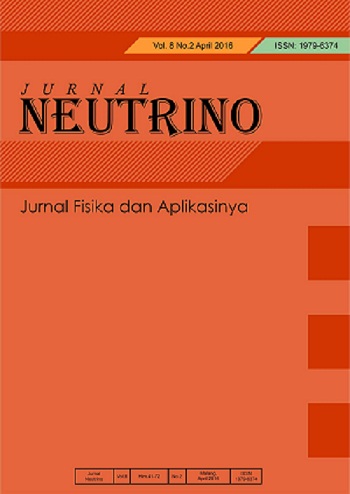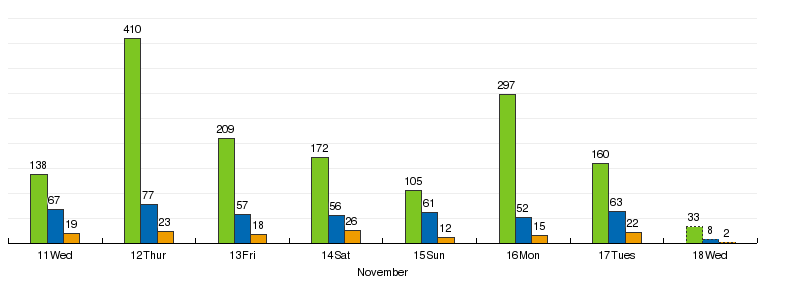SOC (STATE of CHARGE) THREE-CELL LEAD DYNAMIC BATTERY MODEL
Abstract
Three-cells dynamic lead-acid battery has been widely manufactured as the latest secondary battery technology. It is being carried out by 10 cycles of charge-discharge treatment with a various types of SoC, such as 100% (Full charge 5100 mAh), 50% (2550 mAh), 25% (1275 mAh) and discharge current of 0.8A. This experiment aims to analyze the treatment of SOC conditions on the performance of the lead-acid battery. The cyclicality test has performed using a Battery Management System (BMS) by applying an electric current at charging 1 A and discharging 0.8A. The results of the SOC charging conditions at 100%, 50%, 25% respectively gave a difference in the value of voltage efficiency of 84%, 87%, 88%, capacity efficiency values of 84%, 80%, 69%, energy efficiency values of 70%, 70%, 62%. The 100% and 50% SOC treatments showed better performance and battery energy the 25% SOC treatment. This research can be a recommendation to predict the performance of the lead-acid battery model during the charging and discharging process.
Keywords
Full Text:
PDFReferences
PLN. Keputusan Menteri Energi Sumber Daya Mineral Republik Indonesia No. 1567 K/21/MEM/2018. 2018.
Lubis, A. Energi Terbarukan Dalam Pembangunan Berkelanjutan. J. Badan Pengkaj. dan Penerapan Teknol. 2007; 8: 155–162.
Azhar M, Satriawan DA. Implementasi Kebijakan Energi Baru dan Energi Terbarukan Dalam Rangka Ketahanan Energi Nasional. Administrative Law and Governance Journal. 2018 Nov 30;1(4):398-412.
Skyllas-Kazacos M, Menictas C, Lim T. Redox flow batteries for medium-to large-scale energy storage. InElectricity Transmission, Distribution and Storage Systems 2013 Jan 1 (pp. 398-441). Woodhead Publishing.
doi:10.1533/9780857097378.3.398.
Alotto P, Guarnieri M, Moro F, Stella A. Redox Flow Batteries for large scale energy storage. In2012 IEEE International Energy Conference and Exhibition (ENERGYCON) 2012 Sep 9 (pp. 293-298). IEEE.
doi:10.1109/EnergyCon.2012.6347770
Minke C, Turek T. Materials, system designs and modelling approaches in techno-economic assessment of all-vanadium redox flow batteries–A review. Journal of Power Sources. 2018 Feb 1;376:66-81.
Zhang J, Jiang G, Xu P, Kashkooli AG, Mousavi M, Yu A, Chen Z. An all-aqueous redox flow battery with unprecedented energy density. Energy & Environmental Science. 2018;11(8):2010-5.
Pan F, Wang Q. Redox species of redox flow batteries: a review. Molecules. 2015 Nov;20(11):20499-517.
Pranata KB, Sulistyanto MP, Amirullah AA, Yusmawanto M, Khairati N, Setiawan YE, Susilo RD, Perwita CA, Istiroyah I, Ghufron M. Static and Dynamic Characteristic Lead Acid Redox Flow Battery. InAIP Conference Proceedings 2021 (Vol. 50007, No. 2018).
Kosta S, Sneha R, Rana K. Design, Fabrication and Electrochemical performance of Soluble Lead Redox-Flow Battery for Energy Storage. In2018 20th National Power Systems Conference (NPSC) 2018 Dec 14 (pp. 1-6). IEEE.
doi:10.1109/NPSC.2018.8771752.
Amit L, Naar D, Gloukhovski R, la O' GJ, Suss ME. A single‐flow battery with multiphase flow. ChemSusChem. 2021 Feb 18;14(4):1068-73.
doi:10.1002/cssc.202002135.
Cheng J, Zhang L, Yang YS, Wen YH, Cao GP, Wang XD. Preliminary study of single flow zinc–nickel battery. Electrochemistry Communications. 2007 Nov 1;9(11):2639-42.
Wang X, Chai J. Redox flow batteries based on insoluble redox-active materials. A review. Nano Materials Science. 2021 Mar 1;3(1):17-24.
doi:10.1016/j.nanoms.2020.06.003.
Zhang, D., Liu, Q. & Li, Y. Design of flow battery. React. Process Des. Sustain. Energy Technol. 61–97 (2014) doi:10.1016/B978-0-444-59566-9.00003-X.
Soloveichik GL. Flow batteries: current status and trends. Chemical reviews. 2015 Oct 28;115(20):11533-58.
Sánchez-Díez E, Ventosa E, Guarnieri M, Trovò A, Flox C, Marcilla R, Soavi F, Mazur P, Aranzabe E, Ferret R. Redox flow batteries: Status and perspective towards sustainable stationary energy storage. Journal of Power Sources. 2021 Jan;481:228804.
Collins J, Kear G, Li X, Low CJ, Pletcher D, Tangirala R, Stratton-Campbell D, Walsh FC, Zhang C. A novel flow battery: A lead acid battery based on an electrolyte with soluble lead (II) Part VIII. The cycling of a 10 cm× 10 cm flow cell. Journal of Power Sources. 2010 Mar 15;195(6):1731-8.
Bates A, Mukerjee S, Lee SC, Lee DH, Park S. An analytical study of a lead-acid flow battery as an energy storage system. Journal of Power Sources. 2014 Mar 1;249:207-18.
Sadeghi S, Javaran EJ. Comparison of combining redox flow and lead‐acid batteries with On‐grid and stand‐alone photovoltaic systems. Environmental Progress & Sustainable Energy. 2019 Sep;38(5):13182.
Santos RM, Alves CL, Macedo EC, Villanueva JM, Hartmann LV, Catunda SY. Lead acid battery SoC estimation based on extended Kalman Filter method considering different temperature conditions. In2017 IEEE International Instrumentation and Measurement Technology Conference (I2MTC) 2017 May 22 (pp. 1-6). IEEE. doi:10.1109/I2MTC.2017.7969966.
Chitnis MS, Pandit SP, Shaikh MN. Electric Vehicle Li-Ion Battery State of Charge Estimation Using Artificial Neural Network. In2018 International Conference on Inventive Research in Computing Applications (ICIRCA) 2018 Jul 11 (pp. 992-995). IEEE.
doi:10.1109/ICIRCA.2018.8597234.
Surendar V, Mohankumar V, Anand S, Prasanna VD. Estimation of state of charge of a lead acid battery using support vector regression. Procedia Technology. 2015 Jan 1;21:264-70.
Ghufron M, Pranata KB, Istiroyah I, Yusmawanto M, Khairati N, Setiawan YE, Susilo RD, Amirullah AA, Perwita CA. Charging time influence on dynamic lead acid battery capacity with H2SO4 electrolyte. InAIP Conference Proceedings 2018 Oct 17 (Vol. 2021, No. 1, p. 050006). AIP Publishing LLC.
Ramadhan FR, Ghufron M, Khairati N, Setiawan YE, Pranata KB. Influence of discharge current on 3 cells dynamic lead-acid batteries performance. InIOP Conference Series: Materials Science and Engineering 2019 Jun 1 (Vol. 546, No. 4, p. 042009). IOP Publishing.
Han J, Kim D, Sunwoo M. State-of-charge estimation of lead-acid batteries using an adaptive extended Kalman filter. Journal of Power Sources. 2009 Mar 15;188(2):606-12.
Huang CS, Balagopal B, Chow MY. Estimating battery pack soc using a cell-to-pack gain updating algorithm. InIECON 2018-44th Annual Conference of the IEEE Industrial Electronics Society 2018 Oct 21 (pp. 1807-1812). IEEE.
Pranata KB, Sulistyanto MP, Ghufron M, Yusmawanto M. Pengaruh Variasi Arus Pengisian Pengosongan Muatan pada Model Baterai Lead Acid Terhadap Perubahan Efisiensi Energi. Jurnal Fisika Flux: Jurnal Ilmiah Fisika FMIPA Universitas Lambung Mangkurat. 2019;16(1):42-7.
DOI: https://doi.org/10.18860/neu.v13i2.11835
Refbacks
- There are currently no refbacks.
Copyright (c) 2021 Kurriawan Budi Pranata, Freygieon Ogiek Rizal Sukma, Muhammad Ghufron, Masruroh Masruroh

This work is licensed under a Creative Commons Attribution-NonCommercial-ShareAlike 4.0 International License.
Published By:
Program Studi Fisika Fakultas Sains dan Teknologi Universitas Islam Negeri (UIN) Maulana Malik Ibrahim Malang, Indonesia
B.J. Habibie 2nd Floor
Jl. Gajayana No.50 Malang 65144
Telp./Fax.: (0341) 558933
Email: neutrino@uin-malang.ac.id
This work is licensed under a Creative Commons Attribution-NonCommercial-ShareAlike 4.0 International License
View My Stats











